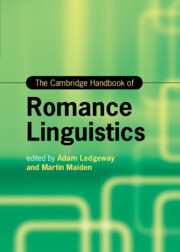Book contents
- The Cambridge Handbook of Romance Linguistics
- Cambridge Handbooks in Language and Linguistics
- The Cambridge Handbook of Romance Linguistics
- Copyright page
- Dedication
- Contents
- Figures
- Tables
- Contributors
- Abbreviations
- 1 Data, Theory, and Explanation: The View from Romance
- Part One What Is a Language?
- 2 Origins of Romance
- 3 Documentation and Sources
- 4 Variation in Romance
- Part Two Phonetics and Phonology
- Part Three Morphology
- Part Four Syntax
- Part Five Semantics and Pragmatics
- Part Six Language, Society, and the Individual
- Index
- References
4 - Variation in Romance
from Part One - What Is a Language?
Published online by Cambridge University Press: 23 June 2022
- The Cambridge Handbook of Romance Linguistics
- Cambridge Handbooks in Language and Linguistics
- The Cambridge Handbook of Romance Linguistics
- Copyright page
- Dedication
- Contents
- Figures
- Tables
- Contributors
- Abbreviations
- 1 Data, Theory, and Explanation: The View from Romance
- Part One What Is a Language?
- 2 Origins of Romance
- 3 Documentation and Sources
- 4 Variation in Romance
- Part Two Phonetics and Phonology
- Part Three Morphology
- Part Four Syntax
- Part Five Semantics and Pragmatics
- Part Six Language, Society, and the Individual
- Index
- References
Summary
This chapter elaborates on two case studies in structural variation to illustrate how the comparison of closely related grammatical systems fuels research questions on general theoretical issues. Our first case study regards subject clitics in central Romance dialects. Subject clitics have been studied extensively over recent decades, but they still raise several questions concerning the nature of null subject languages. Analogously, there is a huge literature on the selection of perfective auxiliaries – the second case study in our chapter – and, as in the case of subject clitics, lesser-known non-standard dialects display a kaleidoscope of auxiliation options whose rationalization poses fascinating analytical challenges and yields insights into basic issues of linguistic theory. The core question raised by our case studies concerns the modelling of linguistic diversity: do the above phenomena result from a finite set of discrete parameters or emerge from random language-specific options? We argue that the otherwise ‘hyperastronomical’ number of possible grammars is aptly constrained by syntactic factors, although inflexional morphology – which syntax cannot control entirely – may have a role in the realization of specific auxiliary or subject clitic forms in each dialect and for each person.
- Type
- Chapter
- Information
- The Cambridge Handbook of Romance Linguistics , pp. 150 - 180Publisher: Cambridge University PressPrint publication year: 2022
References
Selected References
- 1
- Cited by



